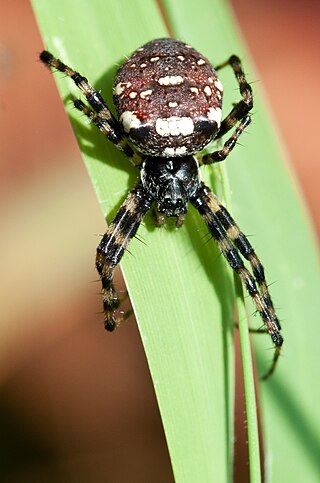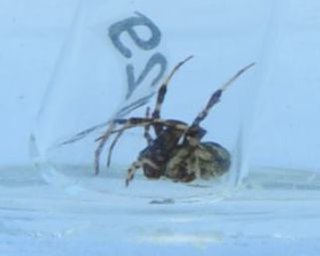
Heptathela kimurai, the Kimura spider, or kimura-gumo, is an Old World spider, found primarily in Japan and named after Arika Kimura, who collected it in 1920. It belongs to the sub-order Mesothelae and can reach up to 3 cm in length. Its burrows are covered by a camouflaged "pill box" flap.

The genus Argiope includes rather large spiders that often have a strikingly coloured abdomen. These spiders are distributed throughout the world. Most countries in tropical or temperate climates host one or more species that are similar in appearance. The etymology of Argiope is from a Latin word argentum meaning silver. The carapace of Argiope species is typically covered in silvery hairs, and when crawling in the sun, they reflect it in a way that gives them a metallic, white appearance.

The Mygalomorphae, or mygalomorphs, are an infraorder of spiders, and comprise one of three major groups of living spiders with over 3000 species, found on all continents except Antarctica. Many members are known as trapdoor spiders due to their creation of trapdoors over their burrows. Other prominent groups include Australian funnel web spiders and tarantulas, with the latter accounting for around one third of all mygalomorphs.

Huntsman spiders, members of the family Sparassidae, are known by this name because of their speed and mode of hunting. They are also called giant crab spiders because of their size and appearance. Larger species sometimes are referred to as wood spiders, because of their preference for woody places. In southern Africa the genus Palystes are known as rain spiders or lizard-eating spiders. Commonly, they are confused with baboon spiders from the Mygalomorphae infraorder, which are not closely related.

The Pholcidae are a family of araneomorph spiders. The family contains more than 1,800 individual species of pholcids, including those commonly known as cellar spider, daddy long-legs spider, carpenter spider, daddy long-legger, vibrating spider, gyrating spider, long daddy, and skull spider. The family, first described by Carl Ludwig Koch in 1850, is divided into 94 genera.

The sac spiders of the family Clubionidae have a very confusing taxonomic history. Once, this family was a large catch-all taxon for a disparate collection of spiders, similar only in that they had eight eyes arranged in two rows and conical anterior spinnerets that touched, and were wandering predators that built silken retreats, or sacs, usually on plant terminals, between leaves, under bark, or under rocks. These are now recognized to include several families, some of which are more closely related to the three-clawed spiders, like lynx and wolf spiders, than to Clubionidae and related families.

The Goliath birdeater belongs to the tarantula family Theraphosidae. Found in northern South America, it is the largest spider in the world by mass and body length, and second to the giant huntsman spider by leg span. It is also called the Goliath tarantula or Goliath bird-eating spider; the practice of calling theraphosids "bird-eating" derives from an early 18th-century copper engraving by Maria Sibylla Merian that shows one eating a hummingbird. Despite the spider's name, it rarely preys on birds.

Scaffold web spiders or cave cobweb spiders (Nesticidae) are a family of araneomorph spiders closely allied with tangle-web spiders (Theridiidae). Like the Theridiidae, these spiders have a comb of serrated bristles on the hind tarsi that are used to pull silk bands from the spinnerets. Nesticidae contains 16 genera and about 300 species, many of which are associated with caves or overhangs. The genus Nesticus is the type for the family and is found throughout the world. The related Eidmannella has speciated considerably in Texas caves and includes some extremely localized species that are considered threatened. One species, Eidmannella pallida, is found in caves and under overhangs, but also in agricultural fields and other habitats away from such restricted areas. The genus Carpathonesticus is found in central Eurasia.

Zoropsidae, also known as false wolf spiders for their physical similarity to wolf spiders, is a family of cribellate araneomorph spiders first described by Philipp Bertkau in 1882. They can be distinguished from wolf spiders by their two rows of eyes that are more equal in size than those of Lycosidae.

Argiope keyserlingi is a species of orb-web spider found on the east coast of Australia, from Victoria to northern Queensland. It is very similar in appearance to a closely related north Queensland species, Argiope aetherea. A. keyserlingi is commonly found in large populations in suburban parks and gardens, particularly among the leaves of Lomandra longifolia. Like many species of orb-web spider, A. keyserlingi shows considerable sexual dimorphism, as the females are many times larger than the males. Mature females can be seen during the summer, and seeing multiple males on the web of one female is not uncommon.

Argiope picta is a species of orb web spider found in tropical areas of Queensland, Australia and Papua New Guinea up to the Moluccas. This species is similar in size to the sympatric Argiope aetherea; females can be distinguished from those of A. aetherea via extensive differences in abdominal colouration and patterns. The males of these two species are almost indistinguishable.

Argiope mascordi is a species of orb-web spider found in Queensland, Australia. The females of this species are smaller and less colourful than many other spiders in the genus Argiope. Males are larger than many other Argiope. Web decorations in this species are interesting in that A. mascordi juveniles construct a cross and adults construct a disc. The reason for this apparent reversal in decorating behaviour remains unknown.

Argiope protensa is a species of the spider genus Argiope known by the common names longtailed orb-weaving spider or tear drop spider. It is found in New Guinea, Australia, New Caledonia and New Zealand.

David de Gea Quintana is a Spanish professional footballer who plays as a goalkeeper. De Gea is currently a free agent.

Argiope catenulata, also known as the grass cross spider, is a species of orb-weaver spiders ranging from India to the Philippines and Papua New Guinea, and also found in Australia in 2019. Like other species of the same genus, it builds a web with a zig-zag stabilimentum.

Gea is a genus of orb-weaver spiders first described by C. L. Koch in 1843.
Simian Undercover Detective Squad is a web series created by The Jim Henson Company under its Henson Alternative banner. A sneak preview of the episode "It's a Mad, Mad, Mad, Mad Goat" appeared on YouTube on August 25, 2009 with the series launching on The Nerdist Channel on April 2, 2012. Some of the episodes were released on the Microsoft Zune Video Marketplace.

Argiope magnifica is a species of orb web spider found in tropical areas of north-east Queensland, Australia, eastern Papua New Guinea and the Solomon Islands. It is commonly known as the magnificent St Andrew's cross spider. This species is similar in size to the sympatric Argiope keyserlingi; females can be distinguished from those of A. keyserlingi via extensive differences in abdominal colouration and patterns. The males of these two species are almost indistinguishable.

Coras lamellosus is a species of funnel weaver in the family of spiders known as Agelenidae. It is found in the United States.

Gea eff is a species of orb-weaver spider. It is found in Papua New Guinea. The arachnologist Herbert Walter Levi formally described the species in 1983. While it was still undescribed, Michael H. Robinson and colleagues reported on its courtship and mating behaviors. Gea eff has the shortest scientific name of any spider species.





















